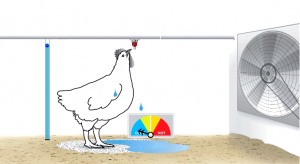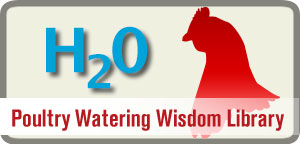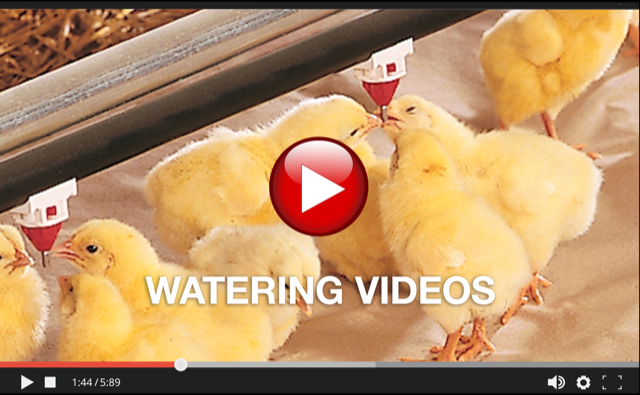In our previous article on consumption vs. usage, we made clear that the amount of water usage (WU) being recorded reflects two things going on in the bird house: water consumption (WC) and water spillage (WS). We noted this to emphasize that discharging more water at each drinker by increasing the water pressure doesn’t mean the birds will drink more, as they can only capture so much water in their beaks with each peck of the trigger pin. Drinkers discharging more water than bird beaks can hold simply results in more spillage. Click here to see a dramatic slow-motion video of how birds drink.
If the spillage reaches the point where the litter gets too wet, it creates an environment that can harm the bird (increased ammonia, pododermatitis, more disease challenges, among other things). The solution is to pay close attention to litter conditions and manage the water pressure in small increments until the litter has a less threatening moisture content (about 25 percent), which means less water is being spilled while the birds drink their fill.
However, looking at this process a little closer, we can identify situations where excessive spillage may not always end up wetting the litter. Heat and different litter materials can be factors in keeping litter drier. But it is especially when ventilation fans are working hard in the summertime that any spillage can quickly evaporate, leaving the litter acceptably dry.
Seeing dry litter, it is quite easy for watering system managers to conclude that not much is being spilled, so the birds must be able to “handle more water.” And indeed in the heat of the summer you would expect the warmer birds to be drinking more water, and the system manager can see by the water meter that water usage is going up. It seems natural to conclude from these facts and the dry litter that it would be a good idea to ratchet up the water pressure to make sure the birds are getting “plenty of water.”
But this is potentially counterproductive thinking. Increasing the water pressure too aggressively does not mean more water is consumed by the bird. As we noted above, birds can only hold so much water in their beaks with each peck. If the water comes out more quickly and more abundantly with each peck, which is the result of the increased pressure, more water is NOT going into the bird. More water is being spilled. The birds may indeed be drinking more water because of the heat, but it is not because they have grown bigger beaks, but because they are most likely taking more pecks, hitting the nipple trigger pins MORE OFTEN in the course of a day. For the bird, getting enough water simply involves the availability of enough drinking points they can access to drink at a pressure level that allows them to easily fill their beaks. And this pressure level is likely not much different than before the summer season hit.
But OK, you may say. The litter isn’t very wet, so what’s the harm? Failure to account for the increased evaporation of water not ingested by the birds in such heavily ventilated conditions can have a couple of consequences. One is your usage and its impact on your system (and your water bill) will be bigger than it needs to be. The other is that, as creatures of habit we tend to keep going with what seems to be working at the moment rather than adjusting for changing conditions. We have found that producers, once the hottest days have past, are often not quick enough to reduce the water pressure for the cooler weather, letting the litter get too wet for a period of time before they can find the right level of adjustment. Refer to video.
Accordingly, it helps to keep track of your pressure settings by the season. The best solution is to carefully note what your water pressure settings are during the winter months when the ventilation system is not throttled up. You can expect these settings to remain fairly true for the summer with a slight but not dramatic uptick in water pressure needed. Then, when cooler weather sets in again, there will be fewer adjustments needed to achieve the most effective water pressure, thereby reducing waste and the period of time birds are exposed to wet litter.
Next: The problem with trying to determine bird water consumption with “static flow” rates.













